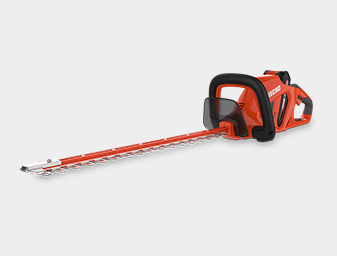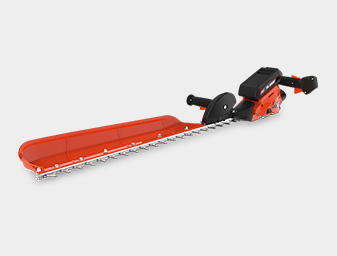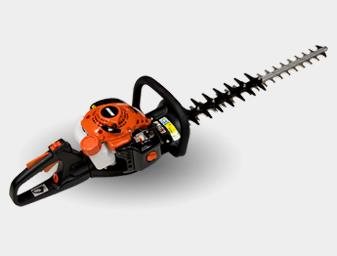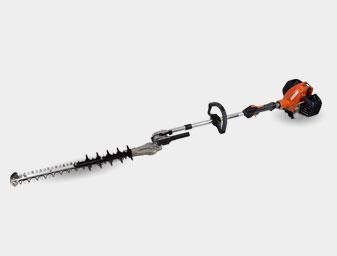How to Trim Hedges
Knowing how to trim hedges properly is essential to landscaping and garden maintenance. Not only do well-maintained, manicured hedges enhance the aesthetic appeal of a property, but trimming also keeps plants healthy. The right hedge trimmer and proper technique simplify the process so you can consistently achieve professional-looking results.
Read on as we explore how to trim bushes with hedge trimmer — we’re covering everything from preparation and technique to how to select the right tool for the job.
Know When to Trim the Hedges
The best time to trim hedges depends on a couple factors, including plant species and your climate.
Early spring is typically the best to address overgrowth; late summer can be optimal for shaping. For most hedges, trimming in late winter or early spring before new growth sprouts is recommended. That said, some flowering shrubs should be pruned after blooming so you don’t accidentally remove flower buds.
You should trim for maintenance regularly throughout the growing season. This encourages healthy growth and allows your hedges to maintain a desired shape. You can trim formal hedges every 6 - 8 weeks during the growing season. Informal hedges might only need to be trimmed once or twice a year.
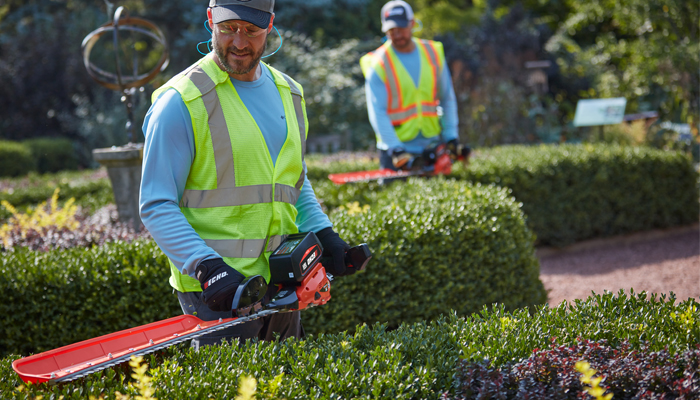
Choosing the Right Hedge Trimmer
You need to find the right hedge trimmer to get the best results. There are two main types of hedge trimmers you should consider: gas- and battery-powered. Each has its own set of advantages:
Gas-powered trimmers pros:
- More cutting power making them suitable for heavy-duty tasks
- Ideal for larger properties
- No charging required
Battery-powered trimmers pros:
- Quieter operation that can be ideal for residential areas
- Lightweight and easier to start reducing user fatigue
- Easier to maintain since they do not need fuel, oil, or spark plugs
There are other things to consider when you’re choosing a trimmer, including your preferences on the following features:
- Blade length: Longer blades cover more area but can make precise work a bit more challenging in terms of manueverability.
- Safety features: Look for hand guards and two-handed operation options.
- Weight and balance: Make sure the trimmer is comfortable to hold, especially if you’ll be working for extended periods.
- Power source: Consider your property size and trimming needs.
For a wide selection of high-quality hedge trimmers that cater to various needs, visit ECHO’s hedge trimmer page.
Preparations Before you Trim
Before you trim the hedges, it’s important to take proper safety precautions and prepare your equipment. This ensures you have a safe and efficient trimming process, reduces the risk of accidents, and improves the quality of your work.
- Wear protective gear: Safety glasses, gloves, and closed-toe shoes. Gas-powered equipment can generate loud noise, so using earplugs or earmuffs will help protect your hearing during operation.
- Inspect your hedge trimmer: Look for any visible damage or loose parts.
- Clear the work area: Remove any obstacles and debris.
- Make sure you have stable footing: Ensure you're standing on flat, stable ground.
- Watch for children and small pets: Keep children and pets away from your work area.
Starting Your Hedge Trimmer (Gas-Powered Models)
Knowing how to start a gas-powered hedge trimmer is important for safety and efficiency. When you follow these instructions, you can keep your trimmer running smoothly.
- Place the trimmer in a clear area on a flat, stable surface — like the ground.
- To prevent the trimmer from moving when you pull the starter cord, firmly hold it down with your left hand on the front handle.
- If the engine is cold, you can engage the choke – do this by moving the lever or switch to the “choke” or “start” position.
- With your right hand, grasp the starter cord handle, pulling it firmly and quickly until you feel resistance. Then, give it a strong, swift pull. Repeat until the engine starts.
- Once the engine starts, let it warm up for a few seconds. If you used the choke, disengage it and begin to trim.
***Always start your trimmer in an open area away from the hedge to avoid accidental contact with the blades.***
Watch this helpful video for a visual guide on starting a gas-powered hedge trimmer.
How to Properly Trim the Hedges
Knowing proper hedge trimming technique is critical for achieving a professional, clean, neat look while ensuring the health of your plants.
Follow these steps when you use your hedge trimmer:
- Start at the bottom of the hedge and work your way up – this ensures even coverage and helps prevent cut branches from falling onto untrimmed areas.
- Keep the trimmer blades parallel to the hedge’s side as you move upward so you get a consistent cutting angle. This promotes even growth.
- You can use a slight inward taper towards the top for vertical sides. Creating this “A” shape lets sunlight reach the lower branches.
- When trimming the top of the hedge, use a flat or slightly rounded shape. You can use a string or level as a guide if you want to ensure evenness.
- While trimming, use smooth, steady strokes. Avoid jerky movements that might create uneven cuts and potentially damage your plants.
- Stepping back every so often allows you to check your progress and spot any unevenness or missed areas.
- If you’re trimming near walls or fences, be extra careful to avoid damaging your trimmer blades or the structure.
- When working on overgrown hedges, follow the three-year rule: remove one-third of the oldest stems each year for three years. This process helps rejuvenate the hedge but doesn’t cause excessive stress.
Your goal is to create a well-shaped hedge where light and air can still reach all parts of the plant – this allows for healthy growth and a fuller appearance.
Pro Tips for Clean and Efficient Trimming
Use the following expert tips to achieve professional-quality results every time you trim a hedge bush. Having a solid hedge-trimming routine does more than improve the appearance of your hedges. It also promotes long-term health and vitality.
- Keep trimmer blades sharp and clean: Sharp blades make cleaner cuts, reducing plant stress and creating a neater appearance. Clean blades prevent the spread of diseases between plants.
- Trim on a cloudy day whenever possible: Direct sunlight stresses freshly cut plants, so overcast conditions are perfect for trimming.
- When trimming dense hedges, take multiple passes: Making rough cuts helps remove excess growth so you can follow up with a finer trim, creating a perfectly polished look.
- Clean up trimmings as you go: Clear your work area to prevent fallen debris from getting tangled in the trimmer or your feet. Some ECHO hedge trimmers come equipped with a full-length debris shield, designed to sweep away cut material as you work and reduce clean-up time.
- Deeply water your hedges 1 - 2 days before trimming: Well-hydrated plants are less likely to be stressed by the trimming process.
- Disinfect your trimmer blades: Between different hedges or if you encounter any diseased sections, disinfecting will prevent the spread of any plant diseases.
- For hedges with larger leaves: Use hand pruners and make a few strategic cuts after machine trimming to get a more natural look and avoid partially cut leaves.
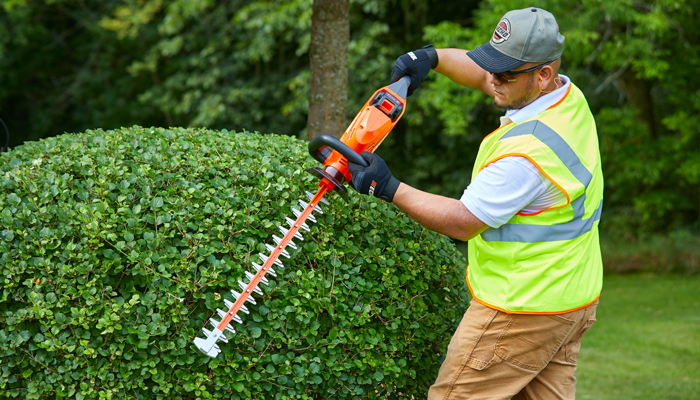
Post-Trimming Maintenance
Proper maintenance of your hedge trimmer after every use will improve longevity and performance. Follow these steps to ensure your trimmer remains in top condition.
- After every use, clean the blades thoroughly: Remove sap, debris, or any accumulated plant material while trimming. You can use a gentle brush or soft cloth to clean the blades, but be careful to avoid any cuts.
- Inspect blades for damage or dullness: If you notice nicks or excessive wear, it might be time to have the blades professionally sharpened or replaced.
- Lubricate the blades to prevent rust: Evenly apply a coat of Red Armor® Blade Cleaner and Lubricant along the length of the blades.
- For gas-powered trimmers: Prevent fuel degradation or other issues by emptying the tank if you won’t use the trimmer for an extended period.
- For battery-powered models: Remove and store the battery in a cool, dry place. Charging your battery periodically – even when not being used – helps maintain its life.
- Store the trimmer: Keep your trimmer in a dry, secure location that’s out of reach of children.
Perform regular maintenance checks: Tighten any loose screws or bolts and check for worn parts that might need to be replaced.
Refer to ECHO’s hedge trimmer maintenance guide for detailed maintenance tips specific to your ECHO model.
Mastering the art of knowing how to trim hedges is key to maintaining beautiful landscaping and healthy plants. Even beginners can achieve professional results when armed with the right tools – like an ECHO hedge trimmer – and prepared with the proper technique.
Regular maintenance of your trimmer and hedges will make things efficient and effective so your landscape can be a source of pride season after season.
Check out ECHO hedge trimmers today!

